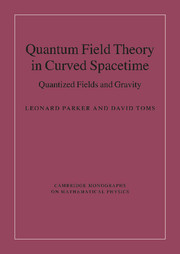Book contents
- Frontmatter
- Contents
- Preface
- Acknowledgments
- Conventions and notation
- 1 Quantum fields in Minkowski spacetime
- 2 Basics of quantum fields in curved spacetimes
- 3 Expectation values quadratic in fields
- 4 Particle creation by black holes
- 5 The one-loop effective action
- 6 The effective action: Non-gauge theories
- 7 The effective action: Gauge theories
- Appendix: Quantized Inflaton Perturbations
- References
- Index
2 - Basics of quantum fields in curved spacetimes
Published online by Cambridge University Press: 25 January 2011
- Frontmatter
- Contents
- Preface
- Acknowledgments
- Conventions and notation
- 1 Quantum fields in Minkowski spacetime
- 2 Basics of quantum fields in curved spacetimes
- 3 Expectation values quadratic in fields
- 4 Particle creation by black holes
- 5 The one-loop effective action
- 6 The effective action: Non-gauge theories
- 7 The effective action: Gauge theories
- Appendix: Quantized Inflaton Perturbations
- References
- Index
Summary
The successful predictions of general relativity are convincing evidence that gravitational phenomena are most clearly understood by regarding spacetime as curved. In general relativity matter exerts its gravitational influence by curving spacetime, and we study the propagation of particles and waves on this curved background. It is then natural to study the propagation of quantum fields in curved spacetimes in order to search for new effects of gravitation. At this level, the gravitational field itself is not quantized, and the methods of Minkowski spacetime quantum field theory are carried over as much as possible. As we shall see, this modest extension of quantum field theory has turned out to be richer in consequences than we could have anticipated.
Among other things, it gives rise to the physically important processes of particle creation in cosmological and black hole spacetimes. The same amplification process that creates particles in an expanding universe is responsible for creating, in the context of an early inflationary expansion, the primordial fluctuations that are now observed with astonishing accuracy in the cosmic microwave background (CMB) radiation. These same primordial fluctuations also appear responsible for the large-scale structure of the universe. The creation of particles by black holes is necessary for maintaining the second law of thermodynamics in their presence. This process of radiation and evaporation of black holes is an important facet in the fundamental search for a microscopic explanation of the entropy of black holes; a search which appears to be leading to new and exciting physics connecting gravitation and quantum theory.
- Type
- Chapter
- Information
- Quantum Field Theory in Curved SpacetimeQuantized Fields and Gravity, pp. 36 - 92Publisher: Cambridge University PressPrint publication year: 2009



